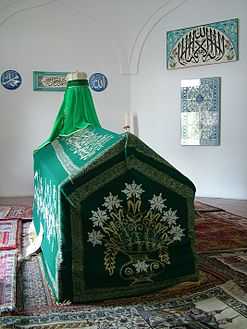Tomb of Gül Baba

Gül Baba's octagonal tomb (türbe) is located on Mecset (mosque) Street, Budapest, a short but steep walk from the Margaret Bridge in the district of Rózsadomb.
History
The tomb was built by Mehmed Paşa, beylerbeyi of Buda,[1] between 1543 and 1548 and has a shallow dome covered with lead plates and wooden tiles.[2] It was left undamaged when the Habsburg armies captured the area during the Second Battle of Buda in 1686, but was converted into a Roman Catholic chapel by the Jesuits, who renamed it "St Joseph's Chapel".
The tomb, in 1916, represented the farthest influence of Bektashism in the Austro-Hungarian Empire.[3]
Ownership
The land later came under the ownership of János Wagner, who maintained the site and allowed access to Muslim pilgrims coming from the Ottoman Empire (see Islam in Hungary). In 1885, the Ottoman government commissioned a Hungarian engineer to restore the tomb and, when work was completed in 1914, it was declared a national monument. The site was restored again in the 1960s and ultimately in the 1990s and is now the property of the Republic of Turkey.
Gallery
-

Aerial view of the building
-
-

-

See also
References
- ↑ Muslim Cultural Enclaves in Hungary under Ottoman Rule, Gabor Ágoston, Acta Orientalia Academiae Scientiarum Hungaricae, T. 45, Fasc. 2/3 (1991), 197.
- ↑ Andrew Peterson, Hungary, Dictionary of Islamic Architecture, (London: Routledge, 1996), 112. ISBN 0-415-06084-2.
- ↑ Geographical Distribution of the Bektashi, F. W. Hasluck, The Annual of the British School at Athens, Vol. 21, (1914/1915 - 1915/1916), 122.
External links
| Wikimedia Commons has media related to Tomb of Gül Baba. |
- Gül Baba Shrine by the Turkish Ministry of Culture
- Gül Baba Tomb in Budapest
Coordinates: 47°30′57.45″N 19°2′5.7″E / 47.5159583°N 19.034917°E
